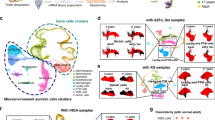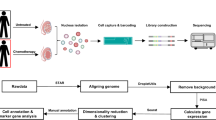Abstract
Each year more than 20,000 children and young persons of reproductive age are exposed to known mutagens in the form of chemo- and/or radiotherapy for cancer in the States1,2. As more of these treatments are effective there is growing concern that genetic defects are introduced in the germ cells of these young patients. It is well documented for male rodents that treatment with chemo- and radio-therapeutic agents before mating can cause genetic damage in the germ line3–10, and the magnitude of heritable effects depends on the spermatogenic celt stage treated. Similar germinal effects are suspected to occur in humans but remain unproven11–15. Hodgkin's disease (HO) is an example of a malignancy which is typically diagnosed during a patient's reproductive years. In our study we observed eight male HD patients who were treated with NOVP (Novanthrone, Oncovin, Vinblastine, Prednisone) chemotherapy. We evaluated sperm aneuploidy using multi-colour fluorescence in situ hybridization (FISH)/and found ∼5-fold increases in sperm with disomies, diploidies and complex genotypes involving chromosome XfY and 8. Increases in sex chromsome aneuploidies arose from segregation errors at meiosis I as well as meiosis II. The aneuploidy effects were transient, however, declining to pretreatment levels within approximately 100 days after the end of the therapy. When compared with normal men, some HD patients showed higher proportions of certain sperm aneupolidy types even before their first therapy.
This is a preview of subscription content, access via your institution
Access options
Subscribe to this journal
Receive 12 print issues and online access
$209.00 per year
only $17.42 per issue
Buy this article
- Purchase on Springer Link
- Instant access to full article PDF
Prices may be subject to local taxes which are calculated during checkout
Similar content being viewed by others
References
Cancer Facts and Figures-1993. 1–27 (American Cancer Society, Atlanta Georgia, 1993).
SEER Cancer Statistics Review:1973–1990(eds.Miller, B.A. et al.) 1.5-1.21,1.25,1.42,1.45, 11.51, XXIV.1-XXIV.13, XXVII. 1-XXVII. 15 (National Cancer Institute, NIH Pub. No. 93–2789,1993).
Chandley, A.C. & Speed, R.M. Testing for nondisjunction in the mouse. Environ. Health Persp. 31, 123–129 (1979).
Meistrich, M.L., Finch, M., da Cunha, M.F., Hacker, U. & Au, W. Damaging effects of fourteen chemotherapeutic drugs on mouse testis cells. Cancer Res. 42, 122–131 (1982).
Russell, L.B. & Shelby, M.D. Tests for heritable genetic damage and for evidence of gonadal exposure in mammals. Mutat. Res. 154, 69–84 (1985).
Lahdetie, J. Induction and survival of micronuclei in rat spermatids. Comparison of two meiotic micronudeus techniques using cyclophosphamide. Mutat. Res. 203, 47–53 (1988).
Russell, L.D. & Russell, J.A. Short-term morphological response of the rat testis to administration of five chemotherapeutic agents. Am. J. Anat. 192, 142–68 (1991).
Adler, I.-D. Synopsis of the in vivo results obtained with the 10 known or suspected aneugens tested in the CEC collaborative study. Mutat. Res. 287, 131–137 (1993).
Kelly, S.M., Robaire, B. & Hales, B.F. Paternal cyclophosphamide exposure causes decreased cell proliferation in cleavage-stage embryos. Biol. Reprod. 50, 55–64 (1994).
Generoso, W.M. et al. Dominant lethal and heritable translation tests with chlorambucil and melphalan in male mice. Mutat. Res. 345, 167–180 (1995).
Li, F., Fine, W., Jaffe, N., Holmes, G.E. & Holmes, F.F. Offspring of patients treated for cancer in childhood. J. Natl. Cancer Inst. 62, 1193–1197 (1979).
Mulvihill, J.J. Sentinel and other mutational effects in offspring of cancer survivors. Mutat Environ. PartC, 179–186 (1990).
Nygaard, R. et al. Reproduction following treatment for childhood leukemia: a population-based prospective cohort study of fertility and offspring. Med. Pediat. Oncol. 19, 459–466 (1991).
Nicholson, H.S., Mulvihill, J.J. & Byrne, J. Late effects of therapy in adult survivors of osterosarcoma and Ewing's sarcoma. Med. Pediatr. Oncol. 20, 6–12 (1992).
Senturia, Y.D., Peckham,, C.S., Peckham, M.J. Children fathered by men treated for testicular cancer. Lancet 2, 766–769 (1985).
Hassold, T.J. & Jacobs, P.A. Trisomy in man. Ann. Rev. Genet. 18, 69–97 (1984).
Jacobs, P.A. et al. Klinefelter's syndrome: an analysts of the origin of the additional sex chromosome using molecular probes. Ann. Hum. Genet. 52, 93–109 (1988).
Hassold, T., Pettay, D., May, K. & Robinson, A. Analysis of nondysjunction in sex chromosome tetrasomy and pentasomy. Hum. Genet. 85, 648–650 (1990).
Jacobs, P.A. The chromosome complement of human gametes, in Oxford Reviews of Reproductive Biology, vol. 14 (ed Milligan S.R.) 47–72 (Oxford University Press, New York, 1992).
Lorda-Sanchez, I., Binkert, F.M. & Schinzel, A. Molecular study of 45, X conceptuses: correlation with clinical findings. Am. J. Med. Genet. 42, 487–490 (1992).
Bishop, J.B. et al. Aneuploidy in germ cells: Etiologies and risk factors. Environ. Mol. Mutag. 28, 159–166 (1996).
Hagemeister, F.B. et al. Treatment of early stages of Hodgkin's disease with novantrone, vincristine, vinblastine, prednisone and radiotherapy. Semin. Hematol. 31, Suppl 36–43 (1994).
Robbins, W.A. et al. Three-probe fluorescence in situ hybridization to assess chromosome X, Y, 8 aneuploidy in sperm of 14 men from two healthy groups: preliminary evidence for an age effect. Reprod. Fertil. Develop. 7, 799–809 (1995).
Wyrobek, A.J., Alhborn, T., Balhorn, R., Stanker, L. & Pinkel, D. Fluorescence in situ hybridization to Y chromosomes in decondensed human sperm nuclei. Mol. Reprod. Dev. 27, 200–208 (1990).
Robbins, W.A., Segraves, R., Pinkel, D. & Wyrobek, A.J. Detection of aneuploid human sperm by fluorescence in situ hybridization: Evidence for a donor difference in frequency of sperm disomk for chromosomes 1 and Y. Am. J. Hum. Genet. 52, 799–807 (1993).
Wyrobek, A.J., Robbins, W.A., Mehraein, Y., Pinkel, D. & Weier, H-U. Detection of sex-chromosomal aneuploidies X-X, Y-Y, and X-Y in human sperm using two-chromosome fluorescence in situ hybridization. Am. J. Med. Genetics. 53, 1–7 (1994).
Brandriff, B. & Gordon, L. Human sperm cytogenetics and one-cell zygote. in Biology of Mammalian Germ Cell Mutagenesis Banbury ♯34: (eds Alien J., Lyon, M.F., Moses, MJ. & Russell, L.B.) 83–194 (Cold Spring Harbor Laboratory Press, 1990).
Griffin, O.K. et al. Nondisjunction studies of human sperm: evidence for a paternal age effect on trisomy. Hum. Mol. Gene. 4, 2227–2232 (1995).
Martin, R.H. et al. An increased frequency of human sperm chromosomal abnormalities after radiotherapy. Mutat. Res. 174, 219–225 (1986).
Martin, R.H. et al. A comparison of chromosomal aberrations induced by in vivo radiotherapy in human sperm and lymphocytes. Mutat. Res. 226, 21–30 (1989).
Genesca, A. et al. Significance of structural chromosome aberrations in human sperm: analysis of induced aberrations. Hum. Genet. 85, 495–499 (1990).
Jenderny, J., Jacobi, M.L., Ruger, A. & Rohrborn, G. Chromosome aberrations in 450 sperm complements from eight controls and lack of increase after chemotherapy in two patients. Hum. Genet. 90, 151–154 (1992).
Brandriff, B.F., Meistrich, M.L., Gorden, LA.,, Carrano, A.V. & Liang,, J.C. Chromosomal damage in sperm of patients surviving Hodgkin's disease following MOPP (nitrogen mustard, vincristine, procarbazine, and prednisone) therapy with and without radiotherapy. Hum. Genet. 93, 295–299 (1994).
Martin, R.H., Rademaker, A.W. & Jeonard, N.J. Analysis of chromosomal abnormalities in human sperm after chemotherapy by karyotyping and fluorescence in situ hybridization (FISH) Cancer Genet. Cytogenet. 80, 29–32 (1995).
Hagemeister, F.B. Are alkylating agents a necessary component in the therapy of Hodgkin's disease. Leuk. Lymphoma 10, 91–97 (1993).
Liang, J.C. et al. A new chemotherapy regimen for treatment of Hodgkin's disease associated with minimal genotoxicity. Leuk. Lymphoma 9, 503–508 (1993).
Meistrich, M.L. Potential genetic risks of using semen collected during chemotherapy. Hum. Reprod. 8, 8–10 (1993).
Carson, S.A., Gentry, W.L., Smith, A.L. & Buster, J.E. Feasibility of semen collection and cryopreservation during chemotherapy. Hum. Reprod. 6, 992–994 (1991).
Meistrich, M.L., Vassilopoulou-Sellin, R. & Lipshultz, L.I. Adverse effects of treatment: gonadal dysfunction. in Principles and Practices of Oncology. 5th edn. (eds Devita, V.T., Hellman, S. & Rosenberg, S.A.) (J.B. Lippincott Co.,Philadelphia, in the press).
Wyrobek, A.J. Methods and concepts in detecting abnormal reproductive outcomes of paternal origin. J. Reprod. Toxicol. 7, 3–16 (1993).
Van Hummelen, P., Lowe, X.R. & Wyrobek, A.J. Simultaneous detection of structural and numerical chromosomal abnormalities in spem of healthy men by multi-color FISH. Hum. Genet. 98, 608–615 (1996).
Author information
Authors and Affiliations
Corresponding author
Rights and permissions
About this article
Cite this article
Robbins, W., Meistrich, M., Moore, D. et al. Chemotherapy induces transient sex chromosomal and autosomal aneuploidy in human sperm. Nat Genet 16, 74–78 (1997). https://doi.org/10.1038/ng0597-74
Received:
Accepted:
Issue Date:
DOI: https://doi.org/10.1038/ng0597-74
This article is cited by
-
What Every Provider Should Know About the 2020–2021 Updated AUA/ASRM Guidelines on Male Factor Infertility
Current Sexual Health Reports (2022)
-
Male Factors: the Role of Sperm in Preimplantation Embryo Quality
Reproductive Sciences (2021)
-
Meiotic spindle assembly checkpoint and aneuploidy in males versus females
Cellular and Molecular Life Sciences (2019)
-
Environmental exposure to pyrethroids and sperm sex chromosome disomy: a cross-sectional study
Environmental Health (2013)



